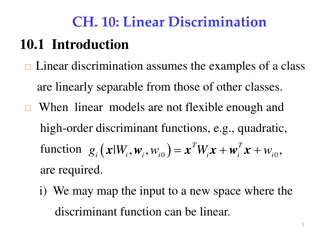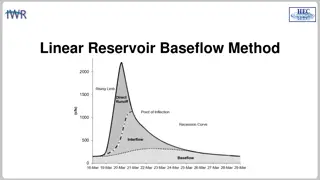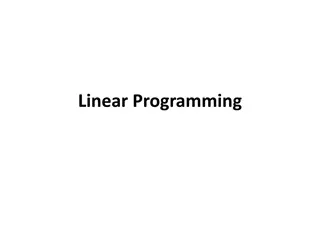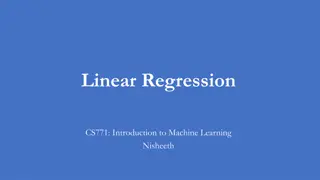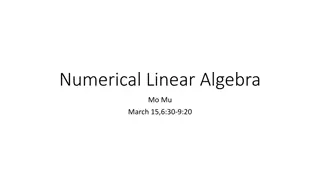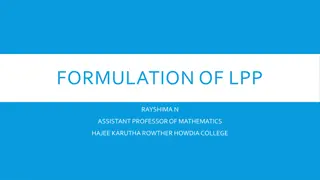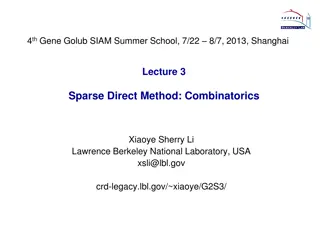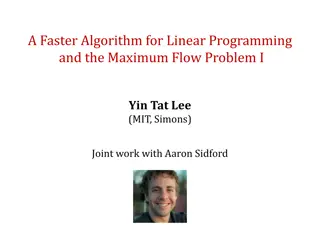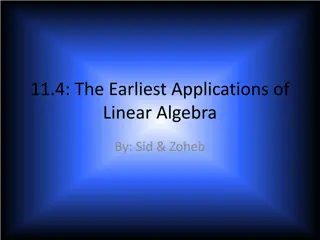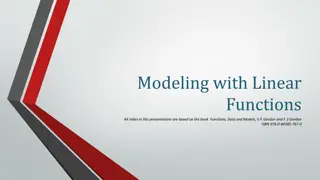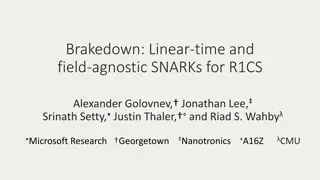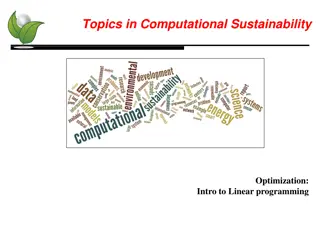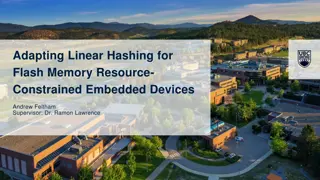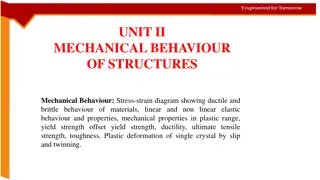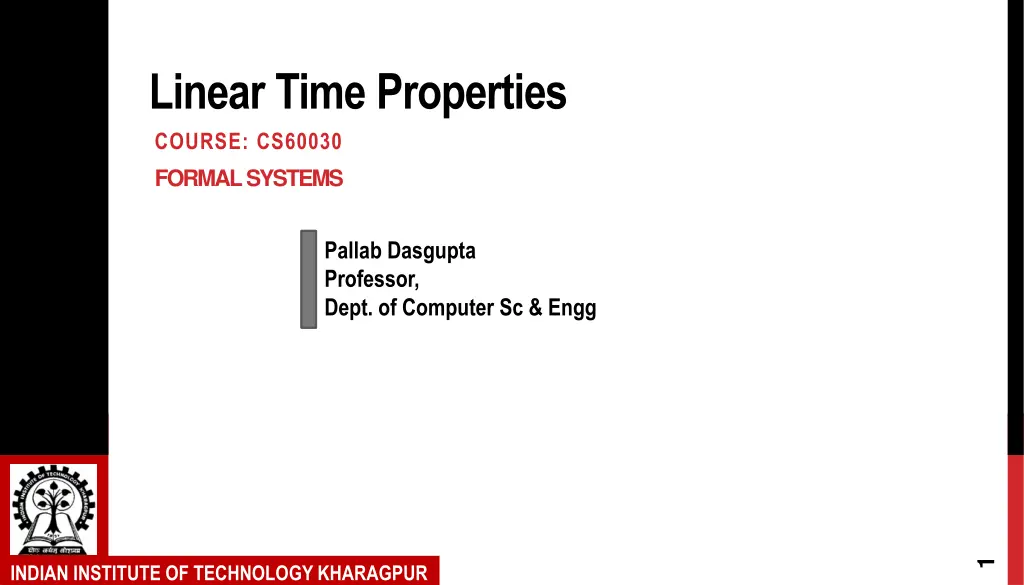
Linear Time Properties CS60030 Formal Systems
Explore linear-time properties in the CS60030 Formal Systems course by Professor Pallab Dasgupta. Dive into topics like trace equivalence, invariants, model checking, executions, state graphs, and path fragments.
Download Presentation

Please find below an Image/Link to download the presentation.
The content on the website is provided AS IS for your information and personal use only. It may not be sold, licensed, or shared on other websites without obtaining consent from the author. If you encounter any issues during the download, it is possible that the publisher has removed the file from their server.
You are allowed to download the files provided on this website for personal or commercial use, subject to the condition that they are used lawfully. All files are the property of their respective owners.
The content on the website is provided AS IS for your information and personal use only. It may not be sold, licensed, or shared on other websites without obtaining consent from the author.
E N D
Presentation Transcript
Linear Time Properties COURSE: CS60030 FORMAL SYSTEMS Pallab Dasgupta Professor, Dept. of Computer Sc & Engg 1 INDIAN INSTITUTE OF TECHNOLOGY KHARAGPUR
Overview Lecture #2 Paths and traces Linear-time (LT) properties Trace equivalence and LT properties Invariants 1
Recall model checking requirements system Formalizing Modeling property specification system model Model Checking location error violated + counterexample satisfied Simulation we now consider: what are properties? 2
Recall executions A finite execution fragment of TS is an alternating sequence of states and actions ending with a state: ........ 2 1 1 0 that such s s s n n = + 1 i 0 . s s for all i n + 1 i i An infinite execution fragment of TS is an infinite, sequence , alternating of states and actions: = ........ 3 + 1 i 0 s s s such that s s for all i + 0 1 1 2 2 1 i i An execution of TS is an initial, maximal execution fragment a maximal execution fragment is either finite ending in a terminal state, or infinite an execution fragment is initial if s0 I 3
State graph The state graph of TS, notation G(TS), is the digraph (V,E) with vertices V = S and edges E = {(s, s ) S S | s' Post(s)} omit all state and transition labels in TS and ignore being initial Post (s) is the set of states reachable G(TS) from s = s * C ( ) * ( ) Post Post s for C S C The notations Pre (s) and Pre (C) have analogous meaning The set of reachable states: Reach(TS) = Post (I ) 4
Path fragments A path fragment is an execution fragment without actions A finite path fragment ?TS is a state sequence: such that si+ 1 Post(si) for all 0 < = i < n where n >= 0 ? = s0 s1 . . . sn An infinite path fragment of TS is an infinite state sequence: = s0 s1 s2 . . . such that si+ 1 Post(si) for all i >=0 A path of TS is an initial, maximal path fragment a maximal path fragment is either finite ending in a terminal state, or infinite a path fragment is initial if s0 I Paths(s) is the set of maximal path fragments with first( ) = s 5
Semaphore-basedmutual exclusion PG1 : PG2 : noncrit1 noncrit2 y := y+ 1 y := y+ 1 wait2 wait1 y > 0 : y := y 1 y > 0 : y := y 1 crit1 crit2 y= 0 means lock is currently possessed ; y= 1 means lock is free 6
Transition system TS(PG1 ||| PG2) (n1, n2, y= 1) y := y+1 y := y+ 1 (n1, w2, y= 1) (w1, n2, y= 1) (c1, n2, y= 0) (w1, w2, y= 1) (n1, c2, y= 0) y := y 1 y := y 1 (c1, w2, y= 0) (w1, c2, y= 0) 7
Traces Actions are mainly used to model the (possibility of) interaction synchronous or asynchronous communication Here, focus on the states that are visited during executions the states themselves are not observable , but just their atomic propositions Consider sequences of the form L(s0) L(s1) L(s2) ... just register the (set of) atomic propositions that are valid along the execution instead of execution s this is called a trace s 1 0 1 s . . . 2 0 For a transition system without terminal states: traces are infinite words over the alphabet 2AP, i.e., they are in(2AP) 9
Traces Let transition system TS = (S, Act, , I , AP, L) without terminal states. all maximal paths (and excutions) are infinite The trace of path fragment = s0s1... is trace( ) = L(s0) L(s1) ... the trace of ? = s0s1. . . sn is trace( ?) = L(s0) L(s1) . . . L(sn) The set of traces of a set of paths: trace( ) = {trace( ) | } T races(s) = trace(Paths(s)) T races(TS) = s I T races(s) T racesfin (s) = trace(Paths fin (s)) T racesfin (TS) = s ITracesfin (s) 10
Example traces Let AP = {crit1,crit2} Example path: = (n1, n2, y = 1) (w1, n2, y = 1) (c1, n2, y = 0) (n1, n2, y = 1) (n1, w2, y = 1) (n1, c2, y = 0) . . . The trace of this path is the infinite word: trace( ) = {crit1} {crit2} {crit1} {crit2}... The trace of the finite path fragment: ? = (n1, n2, y = 1) (w1, n2, y = 1) (w1, w2, y = 1) (w1, c2, y = 0) (w1, n2, y = 1) (c1, n2, y = 0) is: trace( ?) = {crit2} {crit1} 11
Linear-time properties Linear-time properties specify the traces that a TS must exhibit LT-property specifies the admissible behaviour of system under consideration later, a logic will be introduced for specifying LT properties A linear-time property (LT property) over AP is a subset of (2AP ) finite words are not needed, as it is assumed that there are no terminal states TS (over AP) satisfies LT property P (over AP): TS | = P if and only if T races(TS) P TS satisfies the LT property P if all its observable behaviors are admissible state s S satisfies P , notation s | = P , whenever Traces(s) P 12
How to specify mutual exclusion? Always at most one process is in its critical section Let AP = {crit1,crit2} other atomic propositions are not of any relevance for this property Formalization as LT property Pmutex = set of infinite words A0 A1 A2 . . . with { crit1, crit2 } Ai for all 0 i Contained in Pmutex are e.g., the infinite words: ({crit1}{crit2}) and {crit1}{crit1}{crit1}. . . and . . . but not {crit1} {crit1, crit2}. . . or {crit1}, {crit1, crit2} . . . Does the semaphore-based algorithm satisfy Pmutex? 13
Does the semaphore-based algorithm satisfy Pmutex ? (n1, n2, y= 1) (w1, n2, y= 1) (n1, w2, y= 1) (c1, n2, y= 0) {crit1} {crit2 } (n1, c2, y= 0) (w1, w2, y= 1) {crit1 } (c1, w2, y= 0) (w1, c2, y= 0) {crit2 } Y es as there is no reachable state labeled with {crit1, crit2} 14
How to specify starvation freedom? A process that wants to enter the critical section is eventually able to do so Let AP = {wait1,crit1,wait2,crit2} Formalization as LT -property Pnostarve =set of infinite words A0 A1 A2 . . . such that: 2 , 1 { ( . ) ( . ) } j wait A j crit A for each i i j i j . 0 : ( . ) ( . ) there exist in finitely many j wait A k j k wait A i j i j Does the semaphore-based algorithm satisfy Pnostarve? 15
Does the semaphore-based algorithm satisfy Pnostarve ? (n1, n2, y= 1) {wait2 } (n1, w2,y= 1) {wait1 } (w1, n2,y= 1) {wait1, wait2 } (w1, w2, y= 1) (c1, n2, y= 0) {crit1} {crit2 } (n1, c2, y= 0) {crit1, wait2} (c1, w2, y= 0) (w1, c2, y= 0) {wait1, crit2 } No. Trace ({ wait2 } { wait1, wait2 } { crit1, wait2 } ) Traces(TS), but Pnostarve 16
Mutual exclusion algorithm revisited (n1, n2, y= 1) (w1, n2, y= 1) (n1, w2, y= 1) (c1, n2, y= 0) (w1, w2, y= 1) (n1, c2, y= 0) (c1, w2, y= 0) (w1, c2, y= 0) this algorithm satisfies Pmutex 17
Refining mutual exclusion algorithm (n1, n2, y=1) (w1, n2, y= 1) (n1, w2, y= 1) (c1, n2, y= 0) (w1, w2, y= 1) (n1, c2, y= 0) (c1, w2, y= 0) (w1, c2, y= 0) this variant algorithm with an omitted edge also satisfies Pmutex 18
Trace equivalence and LT properties For TS and TS be transition systems (over AP) without terminal states: Traces(TS) Traces(TS ) if and only if | = for any LT property P : TS P implies TS| = P Traces(TS) = Traces(TS ) if and only if TS and TS satisfy the same LT properties 19
Two beverage vending machines pay pay sprite sprite select1 select2 select beer beer AP = {pay, sprite, beer } there is no LT-property that can distinguish between these machines 20
Invariants Safety properties nothing bad should happen [Lamport 1977] Typical safety property: mutual exclusion property the bad thing (having > 1 process in the critical section) never occurs Another typical safety property is deadlock freedom These properties are in fact invariants An invariant is an LT property that is given by a condition for the states and requires that holds for all reachable states e.g., for mutex property crit1 crit2 21
Invariants An LT property Pinvover AP is an invariant if there is a propositional logic formula over AP such that: Pinv= { A0A1A2... (2AP) | j >= 0. Aj |= } is called an invariant condition of Pinv Note that TS | = Pinv trace( ) Pinv for all paths in TS L(s) | = for all states s that belong to a path of TS L(s) | = for all states s Reach(TS) iff iff iff has to be fulfilled by all initial states and satisfaction of is invariant under all transitions in the reachable fragment of TS 22
Checking an invariant Checking an invariant for the propositional formula = check the validity of in every reachable state use a slight modification of standard graph traversal algorithms (DFS and BFS) provided the given transition system TS is finite Perform a forward depth-first search at least one state s is found with s | the invariance of is violated Alternative: backward search starts with all states where does not hold calculates (by a DFS or BFS) the set s S,s| Pre (s) 23
A naive invariant checking algorithm Input: finite transition system TS and propositional formula Output: true if TS satisfies the invariant always , otherwise false set of state R := ; stack of state U := ; bool b := true; for all s I do if s / R then visit(s) fi od return b (* the set of visited states *) (* the empty stack *) (* all states in R satisfy *) (* perform a dfs for each unvisited initial state *) 24
A naive invariant checking algorithm (* push s on the stack *) (* mark s as reachable *) procedure visit (state s) push(s, U); R := R {s }; repeat s := top(U); if Post(s ) R then pop(U); b := b (s | = ); else let s Post(s ) \ R push(s , U); R := R {s }; fi until (U = ) endproc (* check validity of in s *) (* state s is a new reachable state *) error indication is state refuting initial path fragment s0s1s2. . . sn with si | = (i n) and sn | is more useful 25
Invariant checking by DFS Input: finite transition system TS and propositional formula Output: yes if TS | = always , otherwise no plus a counterexample set of states R := ; stack of states U := ; bool b := true; while (I \R b) do let s I \R; visit(s); od if b then return( yes ) else return( no , reverse(U )) fi (* the set of reachable states *) (* the empty stack *) (* all states in R satisfy *) (* choose an arbitrary initial state not in R *) (* perform a DFS for each unvisited initial state *) (* TS | = always *) (* counterexample arises from the stack content *) 26
Invariant checking by DFS procedure visit (state s) push(s, U); R := R {s }; repeat s := top(U); if Post(s ) R then pop(U); b := b (s | = ); else let s Post(s ) \ R push(s , U); R := R {s }; fi until ((U = ) b) endproc (* push s on the stack *) (* mark s as reachable *) (* check validity of in s *) (* state s is a new reachable state *) 27
Time complexity Under the assumption that s Post(s) can be encountered in time (|Post(s)|) this holds for a representation of Post(s) by adjacency lists The time complexity for invariant checking is O( N (1 + | |) + M ) where N denotes the number of reachable states, and M = s S |Post(s)| the number of transitions in the reachable fragment of TS The adjacency lists are typically given implicitly e.g., by a syntactic description of the concurrent processes as program graphs Post(s) is obtained by the rules for the transition relation 28

